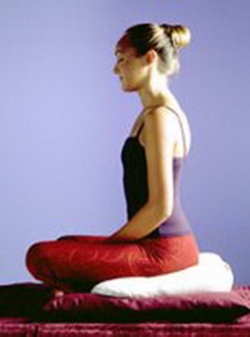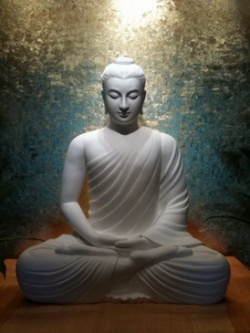Difference between revisions of "Zazen"
| Line 5: | Line 5: | ||
[[Seated meditation]]. The term [[zazen]] specifically indicates the [[form]] of [[seated meditation]] practiced in the [[Zen school]] of [[Buddhism]]. The practice of [[zazen]] is emphasized especially in the [[Sotoschool]] of [[Zen]] in [[Japan]]. [[Seated meditation]] was widely practiced in {{Wiki|ancient India}}. [[Shakyamuni Buddha]] sat in [[meditation]] when he [[attained]] [[enlightenment]] under the [[bodhi tree]], and incorporated the practice into his teachings. [[Seated meditation]] was introduced with [[Buddhism]] to [[China]], where various [[Buddhist]] schools employed it. [[T'ient'ai]] (538-597) [[taught]] it as core to the integrated system of [[disciplines]] he prescribed for observing the [[true nature]] of one's [[mind]]. | [[Seated meditation]]. The term [[zazen]] specifically indicates the [[form]] of [[seated meditation]] practiced in the [[Zen school]] of [[Buddhism]]. The practice of [[zazen]] is emphasized especially in the [[Sotoschool]] of [[Zen]] in [[Japan]]. [[Seated meditation]] was widely practiced in {{Wiki|ancient India}}. [[Shakyamuni Buddha]] sat in [[meditation]] when he [[attained]] [[enlightenment]] under the [[bodhi tree]], and incorporated the practice into his teachings. [[Seated meditation]] was introduced with [[Buddhism]] to [[China]], where various [[Buddhist]] schools employed it. [[T'ient'ai]] (538-597) [[taught]] it as core to the integrated system of [[disciplines]] he prescribed for observing the [[true nature]] of one's [[mind]]. | ||
| − | In [[Zen Buddhism]], [[zazen]] (literally "[[seated meditation]]"; [[Japanese]]: [[坐禅]]; simplified {{Wiki|Chinese}}: [[坐禅]]; {{Wiki|traditional Chinese}}: [[坐禪]]; pinyin: | + | In [[Zen Buddhism]], [[zazen]] (literally "[[seated meditation]]"; [[Japanese]]: [[坐禅]]; simplified {{Wiki|Chinese}}: [[坐禅]]; {{Wiki|traditional Chinese}}: [[坐禪]]; pinyin: [[zuò chán]]; Wade–Giles: [[tso4-ch'an2]]) is a [[meditative]] [[discipline]] practitioners perform to [[calm]] the [[body]] and the [[mind]], and be able to [[concentrate]] enough to [[experience]] [[insight]] into the [[nature]] of [[existence]] and thereby gain [[enlightenment]]. |
Significance | Significance | ||
[[Zazen]] is considered the [[heart]] of [[Zen]] [[Buddhist practice]]. The aim of [[zazen]] is just sitting, that is, suspending all judgmental [[thinking]] and letting words, [[ideas]], images and [[thoughts]] pass by without getting involved in them. | [[Zazen]] is considered the [[heart]] of [[Zen]] [[Buddhist practice]]. The aim of [[zazen]] is just sitting, that is, suspending all judgmental [[thinking]] and letting words, [[ideas]], images and [[thoughts]] pass by without getting involved in them. | ||
| + | |||
Methods | Methods | ||
| − | + | ||
In [[Zen]] [[temples]] and [[monasteries]], practitioners [[traditionally]] sit [[zazen]] as a group in a [[meditation]] hall, usually referred to as the [[zendo]]. The [[practitioner]] sits on a cushion called a [[zafu]], which itself is usually placed on top of a low, flat mat called a [[zabuton]]. | In [[Zen]] [[temples]] and [[monasteries]], practitioners [[traditionally]] sit [[zazen]] as a group in a [[meditation]] hall, usually referred to as the [[zendo]]. The [[practitioner]] sits on a cushion called a [[zafu]], which itself is usually placed on top of a low, flat mat called a [[zabuton]]. | ||
| Line 17: | Line 18: | ||
Before taking one's seat, and after rising at the end of the period of [[zazen]], [[Zen]] practitioners perform a [[gassho]] [[bow]] to their seat, and a second [[bow]] to fellow practitioners. | Before taking one's seat, and after rising at the end of the period of [[zazen]], [[Zen]] practitioners perform a [[gassho]] [[bow]] to their seat, and a second [[bow]] to fellow practitioners. | ||
[[File:Rcxu.jpg|thumb|250px|]] | [[File:Rcxu.jpg|thumb|250px|]] | ||
| − | The beginning of a period of [[zazen]] is [[traditionally]] announced by ringing a [[bell]] three times (shijosho), and the end of a round by ringing the [[bell]] either once or twice (hozensho). | + | The beginning of a period of [[zazen]] is [[traditionally]] announced by ringing a [[bell]] three times ([[shijosho]]), and the end of a round by ringing the [[bell]] either once or twice (hozensho). |
Long periods of [[zazen]] may alternate with periods of [[kinhin]] ([[walking meditation]]). | Long periods of [[zazen]] may alternate with periods of [[kinhin]] ([[walking meditation]]). | ||
| Line 26: | Line 27: | ||
The {{Wiki|legs}} are folded in one of the standard sitting styles: | The {{Wiki|legs}} are folded in one of the standard sitting styles: | ||
| − | [[Kekkafuza]] (full-lotus) | + | [[Kekkafuza]] ([[full-lotus]]) |
| − | [[Hankafuza]] (half-lotus) | + | [[Hankafuza]] ([[half-lotus]]) |
[[Burmese]] (a cross-legged [[posture]] in which the ankles are placed together in front of the sitter) | [[Burmese]] (a cross-legged [[posture]] in which the ankles are placed together in front of the sitter) | ||
[[Seiza]] (a kneeling [[posture]] using a bench or [[zafu]]) | [[Seiza]] (a kneeling [[posture]] using a bench or [[zafu]]) | ||
Revision as of 09:31, 16 August 2014
Seated meditation. The term zazen specifically indicates the form of seated meditation practiced in the Zen school of Buddhism. The practice of zazen is emphasized especially in the Sotoschool of Zen in Japan. Seated meditation was widely practiced in ancient India. Shakyamuni Buddha sat in meditation when he attained enlightenment under the bodhi tree, and incorporated the practice into his teachings. Seated meditation was introduced with Buddhism to China, where various Buddhist schools employed it. T'ient'ai (538-597) taught it as core to the integrated system of disciplines he prescribed for observing the true nature of one's mind.
In Zen Buddhism, zazen (literally "seated meditation"; Japanese: 坐禅; simplified Chinese: 坐禅; traditional Chinese: 坐禪; pinyin: zuò chán; Wade–Giles: tso4-ch'an2) is a meditative discipline practitioners perform to calm the body and the mind, and be able to concentrate enough to experience insight into the nature of existence and thereby gain enlightenment.
Significance
Zazen is considered the heart of Zen Buddhist practice. The aim of zazen is just sitting, that is, suspending all judgmental thinking and letting words, ideas, images and thoughts pass by without getting involved in them.
Methods
In Zen temples and monasteries, practitioners traditionally sit zazen as a group in a meditation hall, usually referred to as the zendo. The practitioner sits on a cushion called a zafu, which itself is usually placed on top of a low, flat mat called a zabuton.
Before taking one's seat, and after rising at the end of the period of zazen, Zen practitioners perform a gassho bow to their seat, and a second bow to fellow practitioners.
The beginning of a period of zazen is traditionally announced by ringing a bell three times (shijosho), and the end of a round by ringing the bell either once or twice (hozensho).
Long periods of zazen may alternate with periods of kinhin (walking meditation). Posture
The posture of zazen is seated, with folded legs and hands, and an erect but settled spine. The hands are folded together into a simple mudra over the belly. In many practices, the practitioner breathes from the hara (the center of gravity in the belly) and the eyelids are half-lowered, the eyes being neither fully open nor shut so that the practitioner is neither distracted by, nor turning away from, external stimuli.
The legs are folded in one of the standard sitting styles:
Kekkafuza (full-lotus) Hankafuza (half-lotus) Burmese (a cross-legged posture in which the ankles are placed together in front of the sitter) Seiza (a kneeling posture using a bench or zafu)
In addition, it is not uncommon for modern practitioners to sit zazen in a chair, often with a wedge/cushion on top of the chair seat so that one is sitting on an incline, or by placing a wedge behind the lower back to help maintain the natural curve of the spine. While each of these styles are commonly taught today, Master Dogen recommended only Kekkafuza and Hankafuza. Types of zazen
In his book Three Pillars of Zen, Philip Kapleau says that practitioners in the Rinzai school face in, towards each other with their backs to the wall, and in the Soto school, practitioners face the wall or a curtain. Kapleau quotes Hakuun Yasutani's lectures for beginners. In lecture four, Yasutani describes the five kinds of zazen: bompu, gedo, shojo, daijo, and saijojo (he adds the latter is the same thing as shikantaza). Instruction
Very generally speaking, zazen practice is taught in one of three ways.
Concentration Koan Introspection Shikantaza (just sitting)
Koan practice is usually associated with the Rinzai school and Shikantaza with the Sōtō school. In reality many Zen communities use both methods depending on the teacher and students. Concentration
The initial stages of training in zazen will usually emphasize concentration. By focusing on the breath at the hara, often aided by counting. This counting meditation is called susokukan, and has several variations. Through this practice one builds up the power of concentration, or joriki. At some Zen centers, the practice of mentally repeating a mantra with the breath is used in place of counting breaths for beginners. In some communities, or sanghas, the practice is continued in this way until there is some initial experience of samadhi or "one-pointedness" of mind. At this point the practitioner moves to one of the other two methods of zazen. Koan Introspection
Having developed awareness, the practitioner can now focus his or her consciousness on a koan as an object of meditation. Since koans are, ostensibly, not solvable by intellectual reasoning, koan introspection is designed to shortcut the intellectual process leading to direct realization of a reality beyond thought. Shikantaza
Shikantaza is a form of meditation, in which the practitioner does not use any specific object of meditation; rather, practitioners remain as much as possible in the present moment, aware of and observing what passes through their minds and around them. Dogen says, in his Shobogenzo, "Sitting fixedly, think of not thinking. How do you think of not thinking? Nonthinking. This is the art of zazen."


